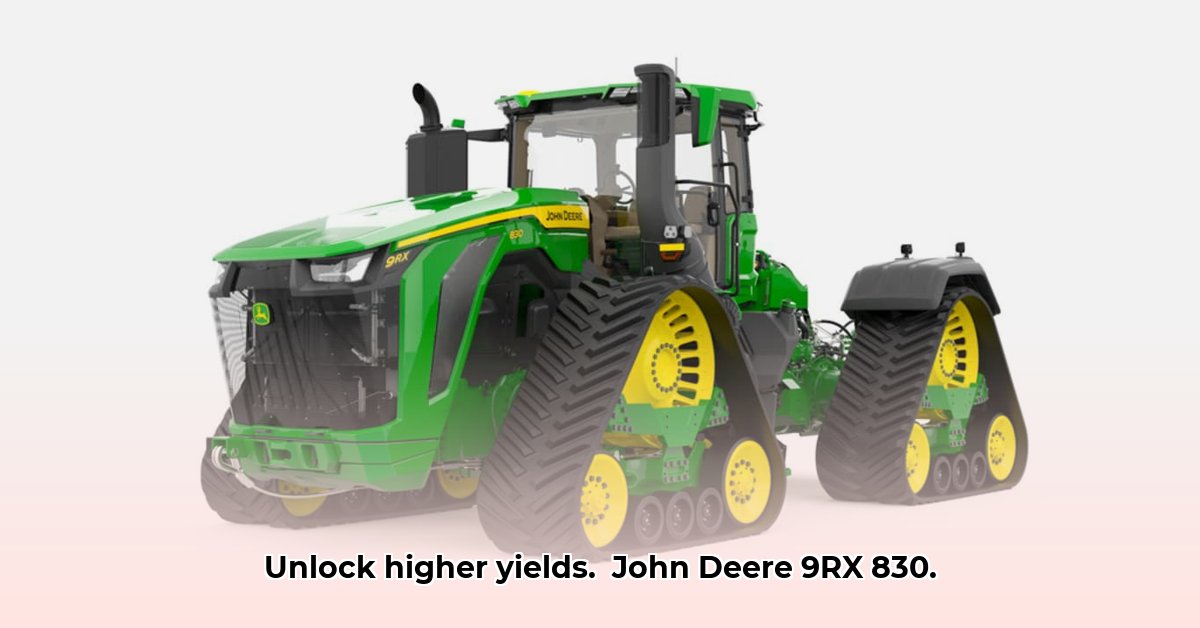
John Deere 9RX 830 Tractor: Optimizing Productivity and Sustainability
The John Deere 9RX 830 represents a significant advancement in agricultural technology, promising increased efficiency and a gentler approach to soil management. This article provides an objective analysis of its features, economic implications, and contribution to sustainable farming practices. We will explore its technical specifications, productivity gains, and potential challenges for farmers of varying scales. For information on older models, check out this helpful resource: Older Deere Tractors.
Technical Specifications and Features
The 9RX 830 boasts a powerful engine, advanced transmission, and a technologically advanced cab designed for operator comfort and efficiency. Key features include the e21 transmission (a continuously variable transmission providing seamless power delivery), the CommandView™ IV Plus cab (offering excellent visibility and ergonomic controls), and John Deere's sophisticated auto-guidance systems. Its impressive size and weight allow for the use of wider implements, significantly increasing daily acreage coverage. Isn't maximizing your operational efficiency a key goal? The 9RX 830 directly addresses this.
Productivity and Efficiency Analysis
Reports suggest the 9RX 830 can increase daily acreage coverage by a significant margin, potentially resulting in a substantial increase in overall productivity. Reduced soil compaction, facilitated by its large tires and advanced powertrain, minimizes the number of passes required across fields. This, in turn, reduces fuel consumption, labor costs, and ultimately translates to higher profits. How much higher? Studies are underway and will shed more light on the actual quantifiable return on investment.
Sustainable Agriculture Implications
Minimized soil compaction is a central benefit of the 9RX 830, promoting improved soil health and water infiltration. However, a comprehensive assessment of its sustainability requires further investigation into fuel consumption, manufacturing emissions, and the overall environmental impact across its lifecycle. Researchers are currently conducting studies to provide a complete picture of its long-term environmental footprint. Isn't long-term sustainability as important as immediate productivity gains?
Economic Considerations: Return on Investment (ROI)
The 9RX 830 carries a high initial investment cost. However, potential ROI hinges on several factors. These include increased productivity, reductions in fuel and labor costs, enhanced soil health leading to higher yields, and the potential to work at an increased operational speed. To calculate ROI, farmers should consider:
- Initial Investment: The purchase price, financing costs (interest rates, loan terms), and potential trade-in values.
- Operating Costs: Fuel, maintenance, repairs, and labor.
- Increased Revenue: Projected yield increases based on improved efficiency and soil health.
- Long-Term Benefits: The continued positive impacts of improved soil health must be projected, which translates into reduced future input costs like fertilizer.
A thorough cost-benefit analysis using discounted cash flow (DCF) analysis is crucial before making a purchase decision. Exploring leasing options or securing agricultural loans can make the investment more manageable. What financing options are best suited to your farm's financial structure?
Technological Dependence and Interoperability
The 9RX 830 heavily relies on John Deere's proprietary technology. While this integration offers advantages in terms of precision and ease of use, it also implies dependence on Deere's service network and potential compatibility issues with equipment from other manufacturers. This factor requires careful consideration for long-term operational flexibility.
Scalability and Accessibility
The high purchase price creates a barrier to entry for smaller farms. This limits the accessibility of its benefits for a large segment of the agricultural community. Innovative financing models and cooperative ownership schemes could help improve access and ensure the technology's benefits reach farmers of all sizes.
Conclusion: A Powerful Tool with Potential Limitations
The John Deere 9RX 830 represents a significant leap forward in agricultural technology, offering substantial increases in productivity and potential contributions to sustainable farming. However, its high cost and dependence on Deere's technology present challenges. A balanced evaluation of ROI, coupled with careful consideration of long-term sustainability and accessibility, is crucial before adopting this powerful machine. The future of agriculture depends on innovation, but also on ensuring equitable access to such innovation.